Differential immune profiles distinguish the mutational subtypes of gastrointestinal stromal tumor
- PMID: 30762585
- PMCID: PMC6486334
- DOI: 10.1172/JCI124108
Differential immune profiles distinguish the mutational subtypes of gastrointestinal stromal tumor
Abstract
Gastrointestinal stromal tumor (GIST) is the most common human sarcoma, frequently characterized by an oncogenic mutation in the KIT or platelet-derived growth factor receptor alpha (PDGFRA) genes. We performed RNA sequencing of 75 human GIST tumors from 75 patients, comprising the largest cohort of GISTs sequenced to date, in order to discover differences in the immune infiltrates of KIT and PDGFRA-mutant GIST. Through bioinformatics, immunohistochemistry, and flow cytometry, we found that PDGFRA-mutant GISTs harbored more immune cells with increased cytolytic activity when compared to KIT-mutant GISTs. PDGFRA-mutant GISTs expressed many chemokines, such as CXCL14, at a significantly higher level when compared to KIT-mutant GISTs and exhibited more diverse driver-derived neoepitope:HLA binding, both of which may contribute to PDGFRA-mutant GIST immunogenicity. Through machine learning, we generated gene expression-based immune profiles capable of differentiating KIT and PDGFRA-mutant GISTs, and also identified additional immune features of high PD-1 and PD-L1 expressing tumors across all GIST mutational subtypes, which may provide insight into immunotherapeutic opportunities and limitations in GIST.
Keywords: Bioinformatics; Cancer immunotherapy; Immunology; Oncogenes; Oncology.
Conflict of interest statement
Figures
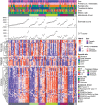
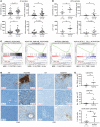
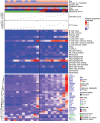
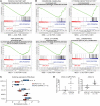
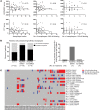
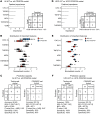
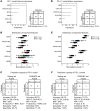
Similar articles
-
Platelet-Derived Growth Factor Receptor-α Regulates Proliferation of Gastrointestinal Stromal Tumor Cells With Mutations in KIT by Stabilizing ETV1.Gastroenterology. 2015 Aug;149(2):420-32.e16. doi: 10.1053/j.gastro.2015.04.006. Epub 2015 Apr 9. Gastroenterology. 2015. PMID: 25865047 Free PMC article.
-
Clinicopathological and molecular features of a large cohort of gastrointestinal stromal tumors (GISTs) and review of the literature: BRAF mutations in KIT/PDGFRA wild-type GISTs are rare events.Hum Pathol. 2017 Apr;62:206-214. doi: 10.1016/j.humpath.2017.01.005. Epub 2017 Feb 1. Hum Pathol. 2017. PMID: 28159677 Review.
-
Differential expression of KIT/PDGFRA mutant isoforms in epithelioid and mixed variants of gastrointestinal stromal tumors depends predominantly on the tumor site.Mod Pathol. 2004 Aug;17(8):889-94. doi: 10.1038/modpathol.3800136. Mod Pathol. 2004. PMID: 15154005
-
Gastrointestinal stromal tumors - Summary of mutational status of the primary/secondary KIT/PDGFRA mutations, BRAF mutations and SDH defects.Pathol Res Pract. 2019 Dec;215(12):152708. doi: 10.1016/j.prp.2019.152708. Epub 2019 Oct 29. Pathol Res Pract. 2019. PMID: 31708372
-
KIT and PDGFRA mutations in gastrointestinal stromal tumors (GISTs).Semin Diagn Pathol. 2006 May;23(2):91-102. doi: 10.1053/j.semdp.2006.08.006. Semin Diagn Pathol. 2006. PMID: 17193822 Review.
Cited by
-
Genomic, transcriptomic, and viral integration profiles associated with recurrent/metastatic progression in high-risk human papillomavirus cervical carcinomas.Cancer Med. 2020 Nov;9(21):8243-8257. doi: 10.1002/cam4.3426. Epub 2020 Oct 5. Cancer Med. 2020. PMID: 33017516 Free PMC article.
-
Integrated Antitumor Activities of Cellular Immunotherapy with CIK Lymphocytes and Interferons against KIT/PDGFRA Wild Type GIST.Int J Mol Sci. 2022 Sep 8;23(18):10368. doi: 10.3390/ijms231810368. Int J Mol Sci. 2022. PMID: 36142281 Free PMC article.
-
The relationship between Ki-67 expression and imaging signs and pathological features in GISTs.Front Surg. 2023 Mar 8;10:1095924. doi: 10.3389/fsurg.2023.1095924. eCollection 2023. Front Surg. 2023. PMID: 36969752 Free PMC article.
-
Tyrosine Kinase Inhibition Activates Intratumoral γδ T Cells in Gastrointestinal Stromal Tumor.Cancer Immunol Res. 2024 Jan 3;12(1):107-119. doi: 10.1158/2326-6066.CIR-23-0061. Cancer Immunol Res. 2024. PMID: 37922405 Free PMC article.
-
Oncogenic KIT Modulates Type I IFN-Mediated Antitumor Immunity in GIST.Cancer Immunol Res. 2021 May;9(5):542-553. doi: 10.1158/2326-6066.CIR-20-0692. Epub 2021 Mar 1. Cancer Immunol Res. 2021. PMID: 33648985 Free PMC article.
References
Publication types
MeSH terms
Substances
Grants and funding
LinkOut - more resources
Full Text Sources
Research Materials
Miscellaneous

